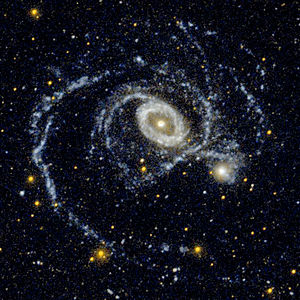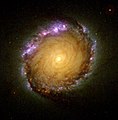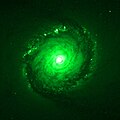NGC 1512
| Galaxy NGC 1512 |
|
|---|---|

|
|
| NGC 1512 (left) together with NGC 1510 (right) recorded in the ultraviolet from GALEX | |
| AladinLite | |
| Constellation | Pendulum clock |
|
Position equinox : J2000.0 , epoch : J2000.0 |
|
| Right ascension | 04 h 03 m 54.3 s |
| declination | -43 ° 20 ′ 56 ″ |
| Appearance | |
| Morphological type | SB (r) from / AGN |
| Brightness (visual) | 10.2 mag |
| Brightness (B-band) | 11.1 mag |
| Angular expansion | 8.9 ′ × 5.6 ′ |
| Position angle | 90 ° |
| Surface brightness | 14.3 mag / arcmin² |
| Physical data | |
| Affiliation | SSRS group 13 NGC 1512 group LGG 108 |
| Redshift | 0.002995 ± 0.000010 |
| Radial velocity | 898 ± 3 km / s |
|
Stroke distance v rad / H 0 |
(33 ± 2) x 10 6 ly (10.2 ± 0.7) Mpc |
| Absolute brightness | (−19.2 ± 0.2) mag |
| Dimensions | 2 · 10 11 M ☉ |
| diameter | 70,000 ly |
| history | |
| discovery | James Dunlop |
| Discovery date | October 29, 1826 |
| Catalog names | |
| NGC 1512 • PGC 14391 • 3114391 • ESO 250-004 • MCG -07-09-007 • IRAS 04022-4329 • 2MASX J04035428-4320558 • SGC 040216-4329.2 • GC 808 • h 2607 • GALEX ASC J040354.27-432057.5 • Part of HIPASS J0403-43 • MBG 04022-4329 • AGC 23162 • LDCE 266 NED022 | |
NGC 1512 is a bar-spiral galaxy with an active nucleus of the Hubble type S0 in the constellation Pendulum Clock in the southern sky . It is an estimated 33 million light years from the Milky Way and about 110,000 light years in diameter .
The elliptical galaxy NGC 1510 is only about four arc minutes southwest of NGC 1512 from Earth . In fact, there is also an interaction between the two galaxies: the latter is a companion galaxy and is responsible for some slight deformations of its outer spiral structure. The two galaxies are also listed together under the designation HIPASS J0403-43 in the HIPASS catalog. A detailed image of the center was taken in a study using the Hubble Space Telescope.
Together with NGC 1510 and NGC 1487 , it forms the small NGC 1512 group .
Photo from the Hubble Space Telescope
In addition to the high-resolution image, the galaxy was imaged by the Hubble telescope in different spectral ranges
The object was discovered by James Dunlop on October 29, 1826 .
NGC 1512 group ( LGG 108 )
| Galaxy | Alternative name | Distance / million ly |
|---|---|---|
| NGC 1487 | PGC 14117 | 31 |
| NGC 1510 | PGC 14375 | 34 |
| NGC 1512 | PGC 14391 | 33 |
Web links
- SIMBAD Astronomical Database
- Hubble Space Telescope
- GALEX
- NGC 1512: A Panchromatic View - Astronomy Picture of the Day of June 6, 2001.
- Astronews
- Astronomie.de
- Spectrum of science







